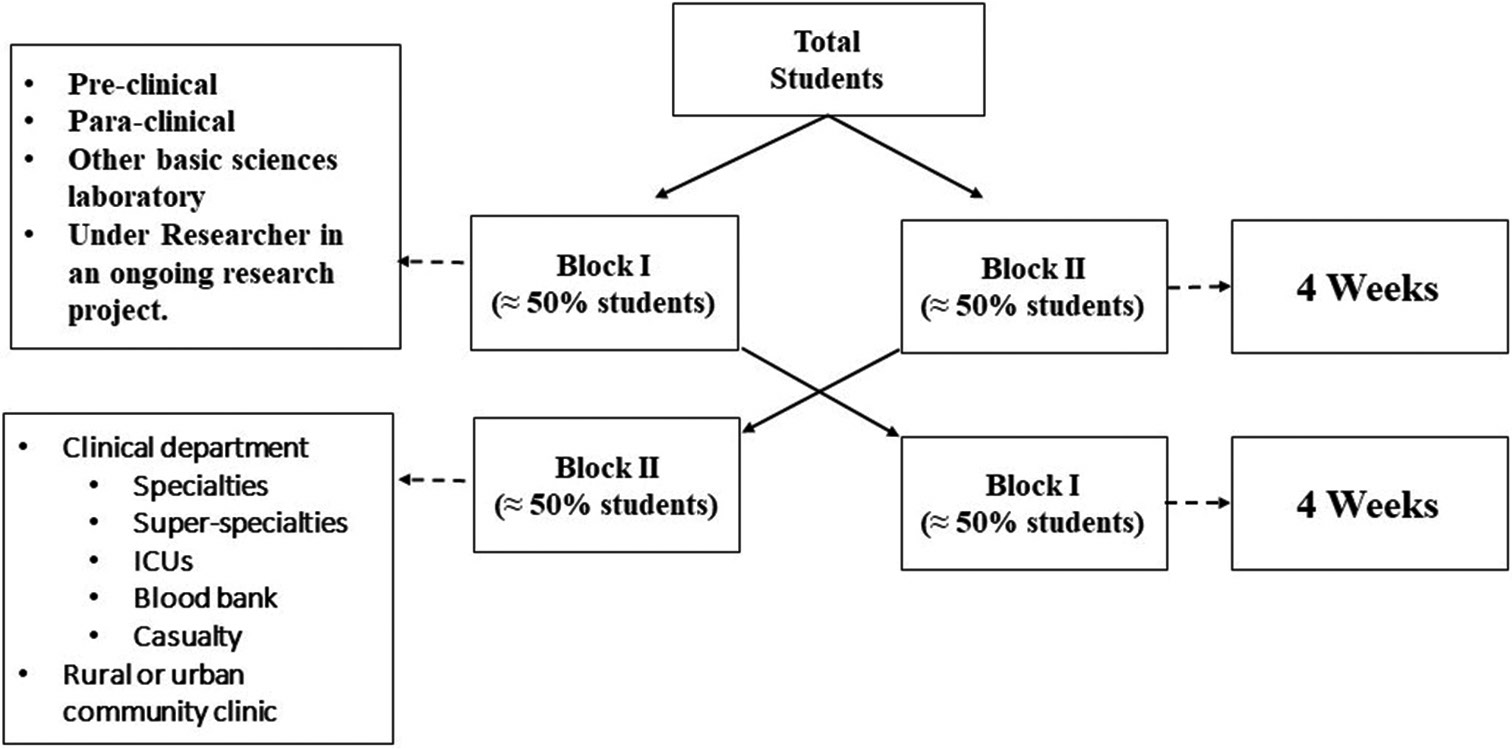Translate this page into:
Electives in Indian medical education: An opportunity to seize

-
Received: ,
Accepted: ,
How to cite this article: Mathur M, Mathur N, Verma A, Kaur M, Patyal A. Electives in Indian medical education: An opportunity to seize. Adesh Univ J Med Sci Res 2022;4:53-5.
The new curriculum introduced in 2019 in Medical Education system is ready to achieve milestones of competency-based medical education with significant pace. The students, faculty, and administrators are figuring out many ideas for smooth implementation of changes as per new curriculum. Various additions such as teaching of attitude and communication, integration, early clinical exposure, electives, and skill training have been observed. Some are old gears in new package while few are completely virgin concepts in Indian scenario like “Electives.”
Electives are defined as learning experiences, which are student centric and created in the curriculum itself to provide opportunities for the learner to reconnoitre, uncover, and explore the areas of interest in the medical profession. These are a group of short courses served during undergraduate period, students get to elect electives as per their interest or career preferences. This self-directed learning activity may provide the opportunity to the student to explore interest area to supplement future study.[1]
As per the new curriculum, 8 weeks, that is, 2 months are deputed for elective rotations after completion of the examination at end of the MBBS Phase III, Part 1 and before commencement of MBBS Phase III, Part 2. Electives are divided into two blocks (4-week duration each), Block 1 electives shall be done in a pre-clinical or paraclinical or other basic sciences (laboratory) or under a researcher in an ongoing research project. On the other hand, Block 2 shall be done in a department of clinical orientation such as specialties, super-specialties, casualty, blood bank, and ICUs. Electives have to be developed and made available in the institution or at an urban or rural community clinic [Figure 1]. The allotment of students in each block of electives could be as per the feasibility at institutional level.

- Student distribution and specialty-wise classification in Block I and Block II of Electives. *Distribution of students in each block of electives could be as per the feasibility at institutional level.
The implementation of electives in western world is ages old and found to have multiple benefits in the form of orienting the students and boosting their interest while in developing countries the reasons for pursuing electives are to gain experience in diverse health-care settings, cultures and demographics, to understand and practice treatment of different set of diseases, and to gain experience not possible through books and at home.[2]
In India, the undergraduate degree program (Bachelor of Medicine and Bachelor of Surgery, MBBS) is 4.5 years of duration, on successful completion of the MBBS program, medical students undergo a compulsory residential rotatory internship (also referred to as internship) for a year. This gives an opportunity for learning under observation and students decide about the specialty, they want to pursue based on the experience, they earn in internship.[3,4]
Still the specialty chosen is based on the marks attained in entrance examination and not entirely on the preference of the student.
Electives offered in Block 1 and 2 are based on resources available in the institutes and this is not standardized till now and is mostly up to the departments what all subjects and zones they are covering in electives for students.
This initiative could be a pathbreaking step in the career of students. This needs a good preparation by departments and faculty to make this a useful endeavor. The sensitization of students and faculty, development of electives on a subject-wise manner, development of allocation procedure of electives to students, etc. are of utmost importance.[5] At present, the standard guidelines are in pipeline and once it is concreted that the opportunity could be utilized for inspiring the students and helping them in making correct decision about their future. Electives will be like a window through which students can peep into the subject they have chosen and understand the working, hardships, and positive aspects of it. The departments can rephrase the electives in the form of strengths, weakness, opportunities, and threats (SWOT) for the students.
SWOT analysis of electives in the form of Strengths of the particular elective, how it will help in achieving the goal of competent Indian Medical Graduate, what all Weaknesses it might have like related to implementation, the learning objectives which could be non-achievable, Opportunities like learning prospects for students during MBBS, and Threats like electives could be taken as holidays by the students.
For example, an elective at Nutritional Rehabilitation Centre (NRC) under Community Medicine can help students to get a first-hand exposure of prevention and management of malnourished under-five children (strength); though the coordination of faculty and staff at NRC and achievement of learning objectives could be challenging (weakness) while students getting an opportunity to observe the functioning of NRC will open excellent learning prospects. If the students even after opting do not attend the elective and just manages to get the certification, they will pose a serious threat to the concept of elective itself.
The opportunity can be seized for exhibiting the community healthcare to the students in the form of electives. Suggested topics in community medicine could be: Evaluation of National Health Programs; Working as a team member in peripheral health-care centers; Planning; and implementation of health education activities at community level.
Here, the process of electives has been shown which includes sensitization of students, application and allotment of electives and the process of electives followed by assessment and certification and evaluation of program as a whole along with the time line as suggested [Figure 2].

- Flowchart showing the implementation process of electives. *Criteria for allotment could be decided by departments or institutes like first come first serve; merit basis; pre-assessment test.
The most recent implementation is expected in the year 2023 and a vigorous brainstorming is already in process at all institutes for planning and implementation of the Electives. It is an opportunity to seize; by institutes and by students.
References
- Electives for the Undergraduate Medical Education Training Program New Delhi: Medical Council of India; 2020. p. :1-30.
- [Google Scholar]
- Medical electives: A chance for international health. J R Soc Med. 2010;103:6-8.
- [CrossRef] [PubMed] [Google Scholar]
- Factors influencing the career preferences of medical students and interns: A cross-sectional, questionnaire-based survey from India. J Educ Eval Health Prof. 2019;16:12.
- [CrossRef] [PubMed] [Google Scholar]
- Electives support autonomy and autonomous motivation in undergraduate medical education. Med Teach. 2014;36:915-6.
- [CrossRef] [PubMed] [Google Scholar]
- Designing and implementation of electives training in competency based medical education curriculum. GAIMS J Med Sci. 2022;2:1-5.
- [Google Scholar]







